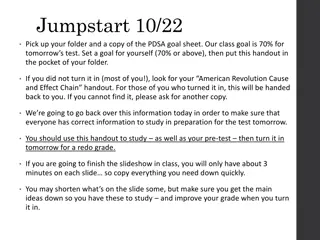Key Events Leading to the American Revolution
The American Revolution was marked by significant events including the French and Indian War, passage of the Stamp Act, Boston Tea Party, Boston Massacre, Intolerable Acts, Battles of Lexington and Concord, publication of Common Sense, Declaration of Independence, and key figures such as George Washington, Thomas Jefferson, John Adams, and Patrick Henry who played crucial roles in shaping the revolutionary movement.
Uploaded on Sep 11, 2024 | 0 Views
Download Presentation

Please find below an Image/Link to download the presentation.
The content on the website is provided AS IS for your information and personal use only. It may not be sold, licensed, or shared on other websites without obtaining consent from the author.If you encounter any issues during the download, it is possible that the publisher has removed the file from their server.
You are allowed to download the files provided on this website for personal or commercial use, subject to the condition that they are used lawfully. All files are the property of their respective owners.
The content on the website is provided AS IS for your information and personal use only. It may not be sold, licensed, or shared on other websites without obtaining consent from the author.
E N D
Presentation Transcript
Trace the chronology of events leading to the American Revolution including the French and Indian War, passage of the Stamp Act, the Boston Tea Party, the Boston Massacre, passage of the Intolerable Acts, the Battles of Lexington and Concord, the publican of Common Sense and the signing of the Declaration of Independence.
Fought in the French and Indian War as well as the American Revolution 2ndContinental Congress appoints Commander in Chief of the Continental Army Revolutionary War: His troops were poorly trained and lacked food, ammunition and other supplies Mount Vernon- name of his home/farm
Lawyer from Massachusetts Helps write the Declaration of Independence The purpose of government is, the greatest quantity of human happiness Helped draft the Treaty of Paris1783 Diplomat to France and Holland 2ndPresident of the U.S.
Governor of Virginia during the American Revolution Central role in drafting the Declaration of Independence Served as a diplomat to France First secretary of state, 2ndVice President, 3rd President
Virginia lawyer and politician Governor of Virginia Led opposition to the Stamp Act of 1765 and Townshend Acts Give me liberty or give me death. -Speech to the Virginia Assembly Opposed the Constitution as a threat to the liberties of the people and the rights of the states
Second cousin to John Adams Organizer of the Boston Sons of Liberty Coordinated Boston s resistance to the Tea Act Actively protests and boycotts
Artesian- Silversmith Apart of the Boston Tea Party Along with William Dawes, warned the colonists that the British were coming to Lexington-1775
Sailor First colonist who died in the Boston Massacre Revolutionary Martyr
French commander who helped Washington s troops train at Valley Forge Increase morale and discipline in American troops Valley Forge: camp for soldiers during harsh winter (1777)
Loyalists were people who were loyal to the kings of England, wanted British laws upheld Examples: government officials, prominent merchants, landowners and some farmers Also known as Tories Patriots thought the British were tyrants Also known as Whigs Examples: artisans, farmers, merchants, planters, lawyers and urban workers. Some Americans did not support either
June 17th, 1775 British wanted to keep control of Boston for its valuable sea ports Fighting took place on Breeds Hill Lacked ammunition Untrained colonists stood up against Britain William Prescott said Don t shoot until you see the whites of their eyes. British win but with heavy causalities Morale booster of American rebels
December 25, 1776 Surrounds group of Hessian mercenaries located across the Delaware River occupying the city of Trenton Hessians- German soldiers paid by the British government to fight Before-Washington s troops were tired, weary, and ready to give up with a cold winter setting in After- An American victory rejuvenated Washington's forces at a much needed time
1777, New York General Burgoyne (British) wanted to divide the colonies in half along the Hudson River Splits his army in half The Battle of Freeman s Farm (First battle of Saratoga) Sept. 19,1777/ British suffer 600 casualties The Battle of Bemis Heights- Oct. 7, 1777 Americans retreated from Freeman s farm to Bemis Heights were the British would loose having nearly 600 casualties Turning point of the American Revolution Improves American Morale Convinces France to aid America with troops and supplies needed to defeat the British
1781 Articles of Capitulation- surrender of the British to American forces. Last major battle of the American Revolution American and French troops surround Yorktown Cornwallis surrenders to Washington Leads to the Treaty of Paris 1783
Treaty that ended the American Revolution September 3, 1783 Britain must recognize US as a new nation with the Mississippi River as the western border Britain gave Florida to Spain France receives colonies in Africa and the Caribbean























